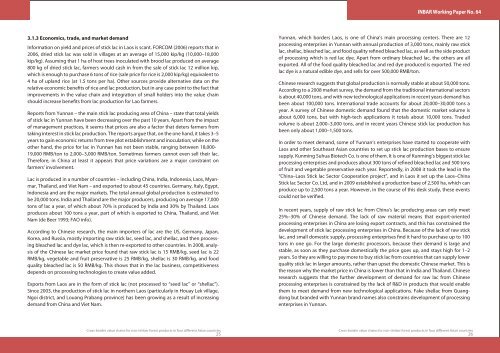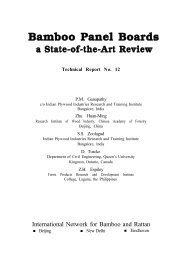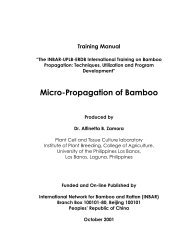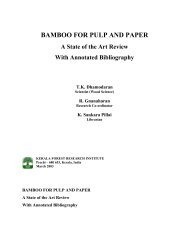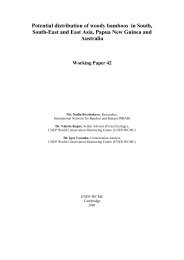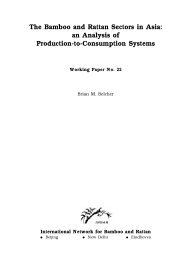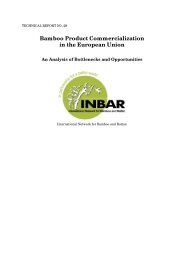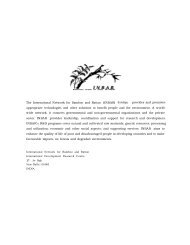Cross-border NTFP value chains - International Network for Bamboo ...
Cross-border NTFP value chains - International Network for Bamboo ...
Cross-border NTFP value chains - International Network for Bamboo ...
Create successful ePaper yourself
Turn your PDF publications into a flip-book with our unique Google optimized e-Paper software.
3.1.3 Economics, trade, and market demand<br />
In<strong>for</strong>mation on yield and prices of stick lac in Laos is scant. FORCOM (2006) reports that in<br />
2006, dried stick lac was sold in villages at an average of 15,000 kip/kg (10,000–18,000<br />
kip/kg). Assuming that 1 ha of host trees inoculated with brood lac produced on average<br />
800 kg of dried stick lac, farmers would cash in from the sale of stick lac 12 million kip,<br />
which is enough to purchase 6 tons of rice (sale price <strong>for</strong> rice is 2,000 kip/kg) equivalent to<br />
4 ha of upland rice (at 1.5 tons per ha). Other sources provide alternative data on the<br />
relative economic benets of rice and lac production, but in any case point to the fact that<br />
improvements in the <strong>value</strong> chain and integration of small holders into the <strong>value</strong> chain<br />
should increase benets from lac production <strong>for</strong> Lao farmers.<br />
Reports from Yunnan – the main stick lac producing area of China – state that total yields<br />
of stick lac in Yunnan have been decreasing over the past 10 years. Apart from the impact<br />
of management practices, it seems that prices are also a factor that deters farmers from<br />
taking interest in stick lac production. The reports argue that, on the one hand, it takes 3–5<br />
years to gain economic returns from tree plot establishment and inoculation; while on the<br />
other hand, the price <strong>for</strong> lac in Yunnan has not been stable, ranging between 18,000-<br />
19,000 RMB/ton to 2,000–3,000 RMB/ton. Sometimes farmers cannot even sell their lac.<br />
There<strong>for</strong>e, in China at least it appears that price variations are a major constraint on<br />
farmers’ involvement.<br />
Lac is produced in a number of countries – including China, India, Indonesia, Laos, Myanmar,<br />
Thailand, and Viet Nam – and exported to about 45 countries. Germany, Italy, Egypt,<br />
Indonesia and are the major markets. The total annual global production is estimated to<br />
be 20,000 tons. India and Thailand are the major producers, producing on average 17,000<br />
tons of lac a year, of which about 70% is produced by India and 30% by Thailand. Laos<br />
produces about 100 tons a year, part of which is exported to China, Thailand, and Viet<br />
Nam (de Beer 1993; FAO info).<br />
According to Chinese research, the main importers of lac are the US, Germany, Japan,<br />
Korea, and Russia, mostly importing raw stick lac, seed lac, and shellac, and then processing<br />
bleached lac and dye lac, which is then re-exported to other countries. In 2008, analysis<br />
of the Chinese lac market price found that raw stick lac is 15 RMB/kg, seed lac is 22<br />
RMB/kg, vegetable and fruit preservative is 25 RMB/kg, shellac is 30 RMB/kg, and food<br />
quality bleached lac is 50 RMB/kg. This shows that in the lac business, competitiveness<br />
depends on processing technologies to create <strong>value</strong> added.<br />
Exports from Laos are in the <strong>for</strong>m of stick lac (not processed to “seed lac” or “shellac”).<br />
Since 2003, the production of stick lac in northern Laos (particularly in Houay Lek village,<br />
Ngoi district, and Louang Prabang province) has been growing as a result of increasing<br />
demand from China and Viet Nam.<br />
<strong>Cross</strong>-<strong>border</strong> <strong>value</strong> <strong>chains</strong> <strong>for</strong> non-timber <strong>for</strong>est products in four dierent Asian countries<br />
25<br />
INBAR Working Paper No. 64<br />
Yunnan, which <strong>border</strong>s Laos, is one of China’s main processing centers. There are 12<br />
processing enterprises in Yunnan with annual production of 3,000 tons, mainly raw stick<br />
lac, shellac, bleached lac, and food quality rened bleached lac, as well as the side product<br />
of processing which is red lac dye. Apart from ordinary bleached lac, the others are all<br />
exported. All of the food quality bleached lac and red dye produced is exported. The red<br />
lac dye is a natural edible dye, and sells <strong>for</strong> over 500,000 RMB/ton.<br />
Chinese research suggests that global production is normally stable at about 50,000 tons.<br />
According to a 2008 market survey, the demand from the traditional international sectors<br />
is about 40,000 tons, and with new technological applications in recent years demand has<br />
been about 100,000 tons. <strong>International</strong> trade accounts <strong>for</strong> about 20,000–30,000 tons a<br />
year. A survey of Chinese domestic demand found that the domestic market volume is<br />
about 6,000 tons, but with high-tech applications it totals about 10,000 tons. Traded<br />
volume is about 2,000–3,000 tons, and in recent years Chinese stick lac production has<br />
been only about 1,000–1,500 tons.<br />
In order to meet demand, some of Yunnan’s enterprises have started to cooperate with<br />
Laos and other Southeast Asian countries to set up stick lac production bases to ensure<br />
supply. Kunming Suhua Biotech Co. is one of them. It is one of Kunming’s biggest stick lac<br />
processing enterprises and produces about 300 tons of rened bleached lac and 500 tons<br />
of fruit and vegetable preservative each year. Reportedly, in 2008 it took the lead in the<br />
“China–Laos Stick lac Sector Cooperation project”, and in Laos it set up the Laos–China<br />
Stick lac Sector Co. Ltd, and in 2009 established a production base of 2,500 ha, which can<br />
produce up to 2,500 tons a year. However, in the course of this desk study, these events<br />
could not be veried.<br />
In recent years, supply of raw stick lac from China’s lac producing areas can only meet<br />
25%–30% of Chinese demand. The lack of raw material means that export-oriented<br />
processing enterprises in China are losing export contracts, and this has constrained the<br />
development of stick lac processing enterprises in China. Because of the lack of raw stick<br />
lac, and small domestic supply, processing enterprises nd it hard to purchase up to 100<br />
tons in one go. For the large domestic processors, because their demand is large and<br />
stable, as soon as they purchase domestically the price goes up, and stays high <strong>for</strong> 1–2<br />
years. So they are willing to pay more to buy stick lac from countries that can supply lower<br />
quality stick lac in larger amounts, rather than upset the domestic Chinese market. This is<br />
the reason why the market price in China is lower than that in India and Thailand. Chinese<br />
research suggests that the further development of demand <strong>for</strong> raw lac from Chinese<br />
processing enterprises is constrained by the lack of R&D in products that would enable<br />
them to meet demand from new technological applications. Fake shellac from Guangdong<br />
but branded with Yunnan brand names also constrains development of processing<br />
enterprises in Yunnan.<br />
<strong>Cross</strong>-<strong>border</strong> <strong>value</strong> <strong>chains</strong> <strong>for</strong> non-timber <strong>for</strong>est products in four dierent Asian countries<br />
26


